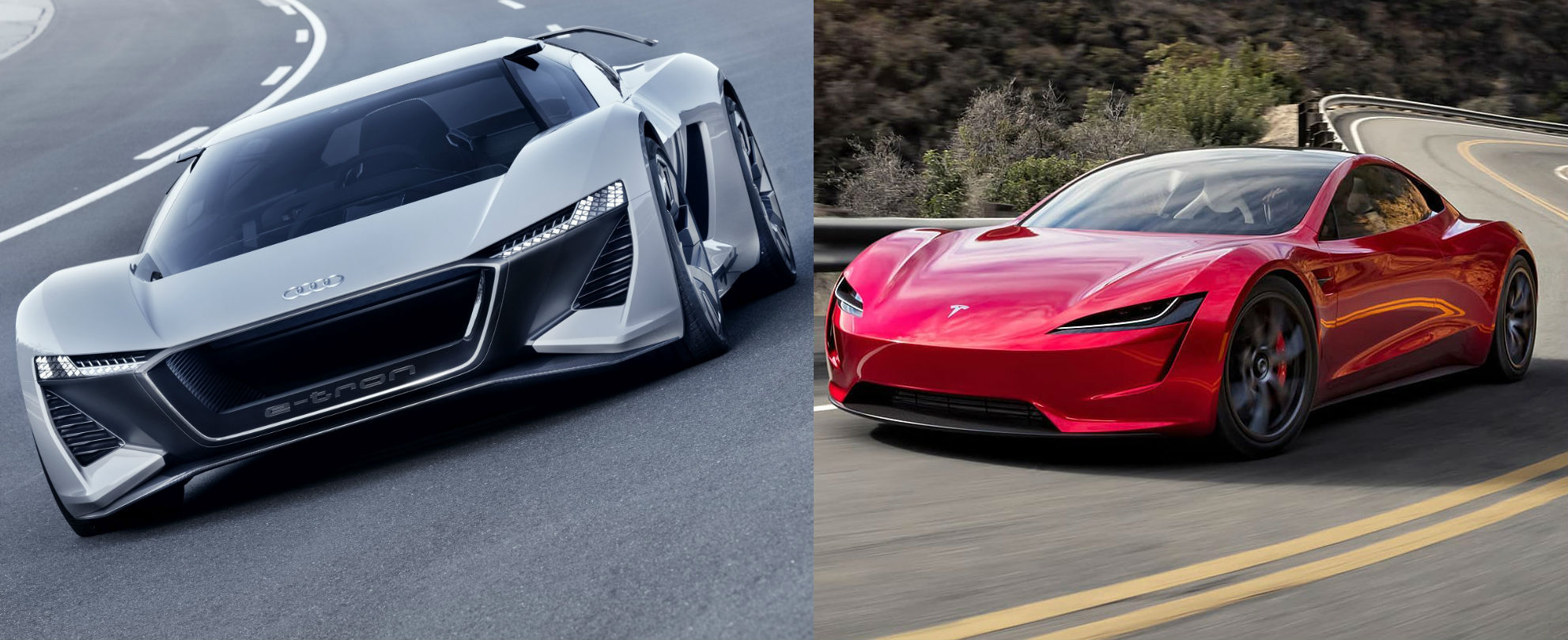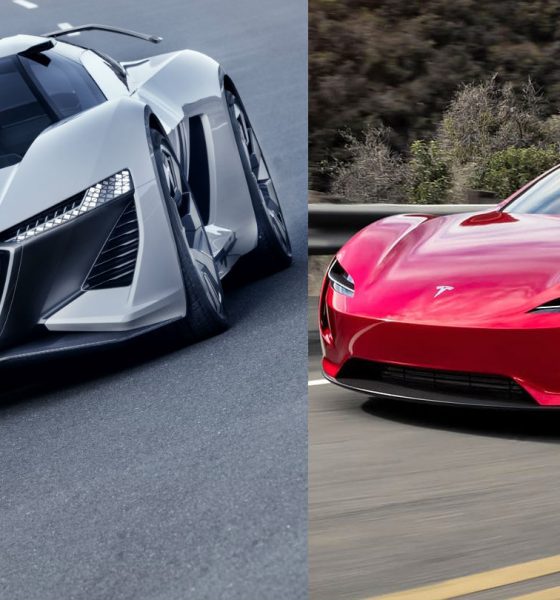

News
Tesla’s next-gen Roadster will have a rival when it enters production, and it’s German-bred
Just like the Model S and the Model 3, Tesla’s next-generation Roadster has the potential to disrupt an industry. In the case of the Roadster, this would be the supercar market — a segment dominated mainly by premium, high-performance vehicles from Europe. With its specs and its price, the Roadster would likely start making waves among supercar enthusiasts once it enters production sometime in 2020.
If recent reports from Germany are any indication, though, a legitimate rival to Tesla’s “hardcore smackdown” to gasoline cars would be waiting for it when it starts rolling off the production floor. In an announcement earlier this month, German automaker Audi noted that it would be bringing its next-generation PB18 e-tron all-electric supercar to low-volume production. With just around 50 units of the vehicle expected to be built, the PB18 e-tron would likely arrive at the market just in time, or even ahead, of the next-gen Tesla Roadster.

Audi’s PB18 e-tron supercar was unveiled last summer, with the German carmaker hyping the vehicle as a car equipped with the best technologies available today, such as an 800-volt charging system and solid-state batteries that can be fully charged in 15 minutes. At the recently-held Mission Zero Event in Amsterdam, Audi boss Bram Schot announced that the supercar, which was initially speculated to be a one-off prototype, would actually be entering low-volume production.
In a press release for the PB18 e-tron, Audi noted that the supercar would be equipped with three electric motors that deliver a power output of 150 kW to the front axle and 350 kW to the rear. Maximum output for the vehicle is 500 kW, though drivers can boost this to 570 kW during operation. Thanks to the electric motors’ combined torque of up to 830-newton meters (612.2 lb-ft), the German-bred electric supercar can accelerate from 0-60 mph in “scarcely more than 2 seconds.”
While certainly impressive, though, Audi’s upcoming all-electric supercar does fall short when compared to some of the next-generation Tesla Roadster’s specs. The Audi PB18 e-tron, for one, comes with a 95 kWh battery pack, which the company states will give the vehicle 500 km (310 miles) of range per charge. The next-generation Tesla Roadster, on the other hand, is equipped with a 200 kWh battery pack that gives the vehicle a range of 1000 km (620 miles) per charge. That said, Audi’s upcoming all-electric supercar is also capable of 350 kW charging, which should make up for the vehicle’s otherwise average range.
Performance figures aside, the Audi PB18 e-tron would likely be priced higher than the Tesla Roadster. With a limited production of just 50 vehicles, Audi could charge top dollar for its all-electric supercar. Thus, it would not be surprising if the PB18 e-tron ends up commanding a price closer to the Rimac C_Two (also a low-volume all-electric supercar priced at $2.1 million) than its Silicon Valley-bred rival. In this sense, the next-generation Tesla Roadster would still be far more attainable than the PB18 e-tron, considering the vehicle’s starting price of $200,000 for the base variant.
Elon Musk notes that the next-generation Tesla Roadster is a supercar designed to take away the halo effect that gas cars have in the performance segment. In classic Elon Musk form, though, the Tesla CEO has announced some pretty crazy ideas for the upcoming vehicle, including a “SpaceX package” that would allow the Roadster to have “hovering” abilities. The base version of the next-gen Tesla Roadster already boasts a 0-60 mph time of 1.9 seconds and a top speed above 250 mph. With the SpaceX package, the vehicle’s specs would likely look, quite literally, out of this world.
Watch Audi’s teaser for the PB18 e-tron supercar in the video below.
https://youtu.be/el-4dupoIWg

News
Tesla FSD fleet is nearing 7 billion total miles, including 2.5 billion city miles
As can be seen on Tesla’s official FSD webpage, vehicles equipped with the system have now navigated over 6.99 billion miles.

Tesla’s Full Self-Driving (Supervised) fleet is closing in on almost 7 billion total miles driven, as per data posted by the company on its official FSD webpage.
These figures hint at the massive scale of data fueling Tesla’s rapid FSD improvements, which have been quite notable as of late.
FSD mileage milestones
As can be seen on Tesla’s official FSD webpage, vehicles equipped with the system have now navigated over 6.99 billion miles. Tesla owner and avid FSD tester Whole Mars Catalog also shared a screenshot indicating that from the nearly 7 billion miles traveled by the FSD fleet, more than 2.5 billion miles were driven inside cities.
City miles are particularly valuable for complex urban scenarios like unprotected turns, pedestrian interactions, and traffic lights. This is also the difference-maker for FSD, as only complex solutions, such as Waymo’s self-driving taxis, operate similarly on inner-city streets. And even then, incidents such as the San Francisco blackouts have proven challenging for sensor-rich vehicles like Waymos.
Tesla’s data edge
Tesla has a number of advantages in the autonomous vehicle sector, one of which is the size of its fleet and the number of vehicles training FSD on real-world roads. Tesla’s nearly 7 billion FSD miles then allow the company to roll out updates that make its vehicles behave like they are being driven by experienced drivers, even if they are operating on their own.
So notable are Tesla’s improvements to FSD that NVIDIA Director of Robotics Jim Fan, after experiencing FSD v14, noted that the system is the first AI that passes what he described as a “Physical Turing Test.”
“Despite knowing exactly how robot learning works, I still find it magical watching the steering wheel turn by itself. First it feels surreal, next it becomes routine. Then, like the smartphone, taking it away actively hurts. This is how humanity gets rewired and glued to god-like technologies,” Fan wrote in a post on X.
News
Tesla starts showing how FSD will change lives in Europe
Local officials tested the system on narrow country roads and were impressed by FSD’s smooth, human-like driving, with some calling the service a game-changer for everyday life in areas that are far from urban centers.

Tesla has launched Europe’s first public shuttle service using Full Self-Driving (Supervised) in the rural Eifelkreis Bitburg-Prüm region of Germany, demonstrating how the technology can restore independence and mobility for people who struggle with limited transport options.
Local officials tested the system on narrow country roads and were impressed by FSD’s smooth, human-like driving, with some calling the service a game-changer for everyday life in areas that are far from urban centers.
Officials see real impact on rural residents
Arzfeld Mayor Johannes Kuhl and District Administrator Andreas Kruppert personally tested the Tesla shuttle service. This allowed them to see just how well FSD navigated winding lanes and rural roads confidently. Kruppert said, “Autonomous driving sounds like science fiction to many, but we simply see here that it works totally well in rural regions too.” Kuhl, for his part, also noted that FSD “feels like a very experienced driver.”
The pilot complements the area’s “Citizen Bus” program, which provides on-demand rides for elderly residents who can no longer drive themselves. Tesla Europe shared a video of a demonstration of the service, highlighting how FSD gives people their freedom back, even in places where public transport is not as prevalent.
What the Ministry for Economic Affairs and Transport says
Rhineland-Palatinate’s Minister Daniela Schmitt supported the project, praising the collaboration that made this “first of its kind in Europe” possible. As per the ministry, the rural rollout for the service shows FSD’s potential beyond major cities, and it delivers tangible benefits like grocery runs, doctor visits, and social connections for isolated residents.
“Reliable and flexible mobility is especially vital in rural areas. With the launch of a shuttle service using self-driving vehicles (FSD supervised) by Tesla in the Eifelkreis Bitburg-Prüm, an innovative pilot project is now getting underway that complements local community bus services. It is the first project of its kind in Europe.
“The result is a real gain for rural mobility: greater accessibility, more flexibility and tangible benefits for everyday life. A strong signal for innovation, cooperation and future-oriented mobility beyond urban centers,” the ministry wrote in a LinkedIn post.
News
Tesla China quietly posts Robotaxi-related job listing
Tesla China is currently seeking a Low Voltage Electrical Engineer to work on circuit board design for the company’s autonomous vehicles.

Tesla has posted a new job listing in Shanghai explicitly tied to its Robotaxi program, fueling speculation that the company is preparing to launch its dedicated autonomous ride-hailing service in China.
As noted in the listing, Tesla China is currently seeking a Low Voltage Electrical Engineer to work on circuit board design for the company’s autonomous vehicles.
Robotaxi-specific role
The listing, which was shared on social media platform X by industry watcher @tslaming, suggested that Tesla China is looking to fill the role urgently. The job listing itself specifically mentions that the person hired for the role will be working on the Low Voltage Hardware team, which would design the circuit boards that would serve as the nervous system of the Robotaxi.
Key tasks for the role, as indicated in the job listing, include collaboration with PCB layout, firmware, mechanical, program management, and validation teams, among other responsibilities. The role is based in Shanghai.
China Robotaxi launch
China represents a massive potential market for robotaxis, with its dense urban centers and supportive policies in select cities. Tesla has limited permission to roll out FSD in the country, though despite this, its vehicles have been hailed as among the best in the market when it comes to autonomous features. So far, at least, it appears that China supports Tesla’s FSD and Robotaxi rollout.
This was hinted at in November, when Tesla brought the Cybercab to the 8th China International Import Expo (CIIE) in Shanghai, marking the first time that the autonomous two-seater was brought to the Asia-Pacific region. The vehicle, despite not having a release date in China, received a significant amount of interest among the event’s attendees.









